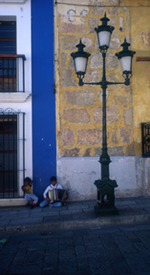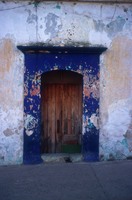 Most
Americans who have traveled to Mexico have never been anywhere but the coast.
Maybe this is for the best -- if Puerto Vallarta, Acapulco, Cancun and Los
Cabos weren't so popular, the inland might be overrun by gringo tourists
and all they leave in their cultural-imperialist wake.
Most
Americans who have traveled to Mexico have never been anywhere but the coast.
Maybe this is for the best -- if Puerto Vallarta, Acapulco, Cancun and Los
Cabos weren't so popular, the inland might be overrun by gringo tourists
and all they leave in their cultural-imperialist wake.
If you're not going to Mexico exclusively for sun and surf, try to head for
Oaxaca, the capital city of the state by the same name. The city, in its
current incarnation, was founded by conquistadors in the middle of
the 16th century (Cortés himself lived there for a while),  and
looks a bit like small European cities of the same vintage. For 2000 years
before the Spaniards showed up, the same area (centered around the now-ruins
of Monte Albán in the hills above the Oaxaca Valley) was a center of
Zapotec and Mixtec civilization.
and
looks a bit like small European cities of the same vintage. For 2000 years
before the Spaniards showed up, the same area (centered around the now-ruins
of Monte Albán in the hills above the Oaxaca Valley) was a center of
Zapotec and Mixtec civilization.
Spend a week. We sat for hours in the sidewalk cafes that ring the zócalo
(central square), wandered through the narrow streets and dreamed at the
colonial buildings, and took our time visiting the traveling markets in the
outlying villages. We hit one or two "must sees" (like the 16th century baroque
cathedral and the aforementioned ruins) every day, but left plenty of time
for watching people, getting lost, eating (see below), and listening to the
nightly "battle of the mariachis" at the zócalo.
Our first night there, we were eating dinner (again, see below) at around
9 o'clock, when we began to hear occasional large explosions outside. ("Oh
boy," we thought, "here comes the EZLN!") When we left the restaurant, the
streets were crowded with people all heading off in one direction. We followed
them to the crowds at the source of the explosions -- a big-as-fourth-of-July
fireworks display being launched from the square in front of another huge
16th-century church. The fireworks accompanied the penultimate night (this
was a Monday!) of what we dubbed the "Fiesta de Santa Tequila," a fair of
twenty-odd mezcál distilleries, hawking their wares and pouring endless
free samples. (Mezcál is the fermented juice of the agave cactus which,
in the better of the samples we tried, tastes a bit like an Islay scotch.)
 August
is the height of the rainy season at the 15th parallel (apparently), so the
temperature was tolerable, the hillsides were green, and the flowers were
blooming in this 6000-foot-above-sea-level mountain valley. The mornings
were overcast, and every day at four o'clock it would rain like crazy. But
everything was dry again by seven or eight, around the time the restaurants
started serving dinner.
August
is the height of the rainy season at the 15th parallel (apparently), so the
temperature was tolerable, the hillsides were green, and the flowers were
blooming in this 6000-foot-above-sea-level mountain valley. The mornings
were overcast, and every day at four o'clock it would rain like crazy. But
everything was dry again by seven or eight, around the time the restaurants
started serving dinner.
FOOD! Oaxaca is famous for its cheese (kind of like a string-cheese mozzarella);
its mole (MOH-lay, not rodent) sauce, a blend of chocolate, herbs, spices,
and other yummy stuff; chapulines -- tiny grasshoppers fried in lemon
and pepper, and absolutely scrumptious no matter what you're thinking; and
mezcál. We had all of these multiple times, and other incredible fare
in between: enchiladas verde, enfrijoladas, carne asada, chiles rellenos,
y más, más, siempre más. Two people can fill themselves to
the gills for as little as four or five bucks apiece.
 It's
not all easy living, though. The poverty is staggering, a fact you can't
ever forget, especially when you're paying a third of what you would for
food and lodging in Europe or the US, or haggling over that vest that you
could certainly afford at the merchant's initial $6 asking price. Be on your
toes about sanitation, otherwise you'll be on the can. And there's no McDonalds,
Starbucks, or Hard Rock Cafe.
It's
not all easy living, though. The poverty is staggering, a fact you can't
ever forget, especially when you're paying a third of what you would for
food and lodging in Europe or the US, or haggling over that vest that you
could certainly afford at the merchant's initial $6 asking price. Be on your
toes about sanitation, otherwise you'll be on the can. And there's no McDonalds,
Starbucks, or Hard Rock Cafe.
But if you're worried about that kind of thing, may I suggest Acapulco?
- nw